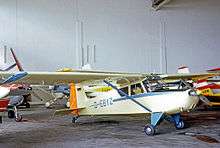Scheibe SF-23 Sperling
The Scheibe SF-23 Sperling (en:Sparrow) is a 1950s German two-seat cabin monoplane or sometimes described as a self-launching motor glider.[1]
| SF-23 Sperling | |
|---|---|
| SF-23A | |
| Role | Two-seat cabin monoplane |
| National origin | Germany |
| Manufacturer | Scheibe Flugzeugbau |
| First flight | 1955 |
| Number built | 27 |
Development

The Sperling was the first design of powered aircraft to come from the Scheibe Flugzeugbau company which had started building gliders in 1951. The prototype first flew on 8 August 1955 and the initial production SF-23A aircraft first flew in September 1958.[2]
The Sperling is a high-wing braced monoplane with side-by-side seating for two in an enclosed cabin.[1] It had a fixed tailwheel landing gear and was initially powered by a 95 hp (71 kW) Continental C90 piston engine.[1][3] The Sperling utilizes mixed construction, the fuselage being a fabric-covered steel-tube structure and the wings being single-spar wooden structures with fabric and plywood covering. Production of the Sperling was completed in 1963.[2]
Operation
Most aircraft produced were sold to German private pilots and flying clubs but one was purchased by a British owner. The higher powered versions were suitable for use in glider-towing. By 2009, seven examples remained in active operation in Germany.[4]
Variants
- SF-23A
- Production variant with a 95 hp (71 kW) Continental C90-12F engine, 17 built.[1]
- SF-23B
- Production variant with a 100 hp (75 kW) Continental O-200-B engine, four built.[1]
- SF-23C
- Production variant with a 115 hp (86 kW) Lycoming O-235 engine, six built.[1]
Specifications (SF-23A)
Data from Jane's All The World's Aircraft 1961–62[5]
General characteristics
- Crew: 2
- Length: 6.20 m (20 ft 4 in)
- Wingspan: 9.87 m (32 ft 5 in)
- Height: 2.18 m (7 ft 2 in)
- Wing area: 12.16 m2 (130.9 sq ft)
- Aspect ratio: 8:1
- Airfoil: NACA 23012
- Empty weight: 460 kg (1,014 lb)
- Gross weight: 730 kg (1,609 lb)
- Fuel capacity: 78 L (21 US gal; 17 imp gal)
- Powerplant: 1 × Continental C90-12F flat-four piston engine, 71 kW (95 hp)
Performance
- Maximum speed: 200 km/h (120 mph, 110 kn)
- Cruise speed: 160 km/h (99 mph, 86 kn) (60% power)
- Never exceed speed: 250 km/h (160 mph, 130 kn)
- Range: 640 km (400 mi, 350 nmi)
- Endurance: 4 hr
- Service ceiling: 5,000 m (16,000 ft)
- Rate of climb: 3.5 m/s (690 ft/min)
References
| Wikimedia Commons has media related to Scheibe SF 23. |
Notes
- Simpson 1991, pp.286–287
- Green 1965, p79
- "Type Certificate Data Sheet: EASA.A.579: SF 23 : Issue 01" (PDF). European Aviation Safety Agency. 16 September 2013. Retrieved 21 April 2019.
- Partington pp.21-46
- Taylor 1961, p. 85
Bibliography
- Green, William; Pollinger G (1965). The Aircraft of the World. London: Macdonald & Co. (Publishers) Ltd. p. 79.
- Partington, Dave (2015). European Registers Handbook 2015. Tonbridge: Air-Britain (Historians) Ltd. pp. 21–46. ISBN 978-0-85130-475-5.
- Simpson, R.W. (1991). Airlife's General Aviation. England: Airlife Publishing. ISBN 1-85310-194-X.
- Taylor, John W. R. (1961). Jane's All The World's Aircraft 1961–62. London: Sampson Low, Marston & Company.CS1 maint: ref=harv (link)